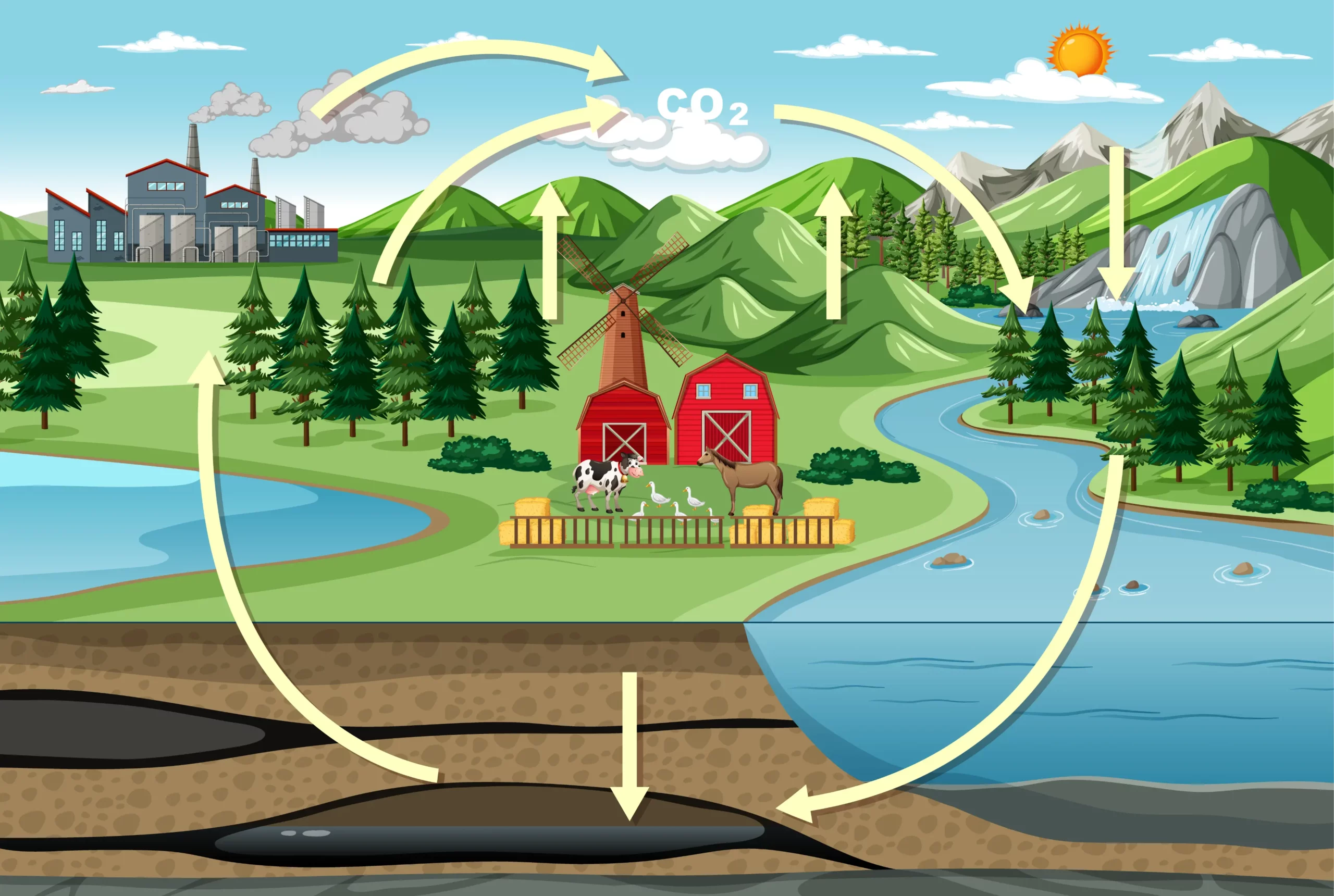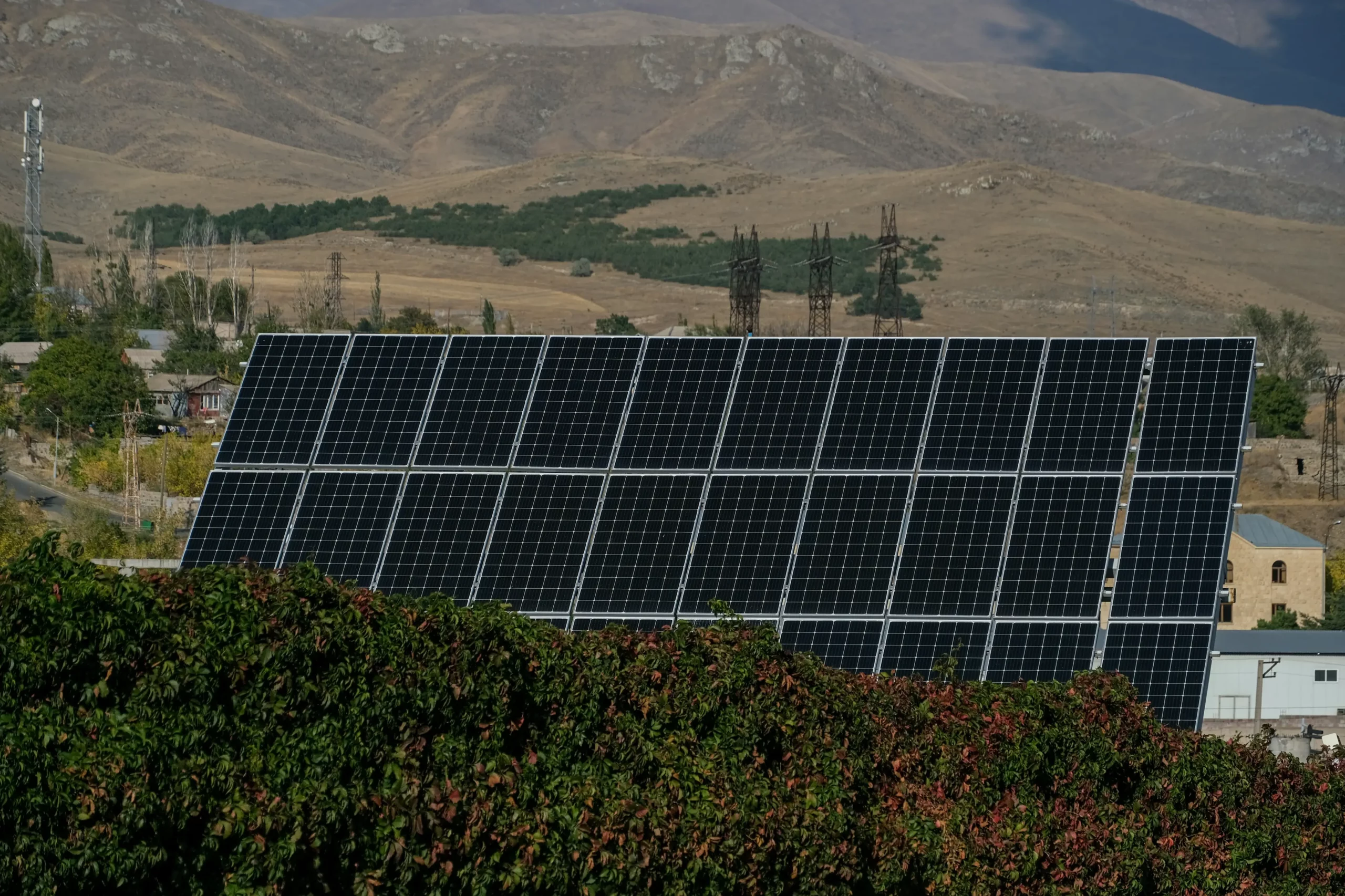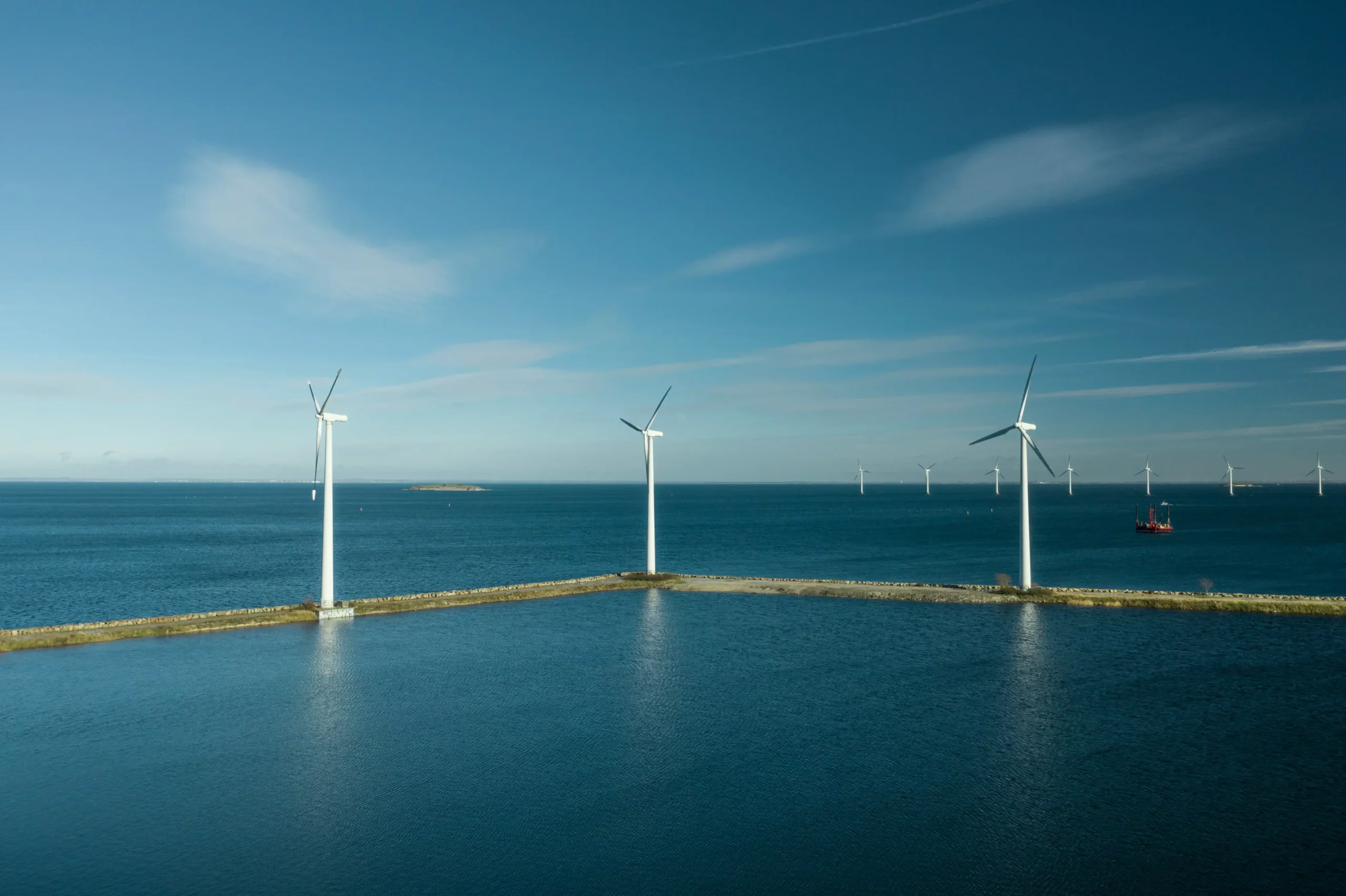
The carbon cycle is a fundamental component of Earth’s system, influencing climate, ecosystem dynamics, and the global distribution of carbon resources. Understanding the carbon cycle is essential in addressing climate change, particularly in the context of integrating sustainable energy solutions. This article delves into the carbon cycle in detail and the crucial role sustainable energy plays in mitigating its imbalances.
What is the Carbon Cycle?

The carbon cycle or carbon dioxide cycle is a fundamental biogeochemical cycle that describes the movement of carbon (C) among the Earth’s lithosphere, biosphere, hydrosphere, and atmosphere. It is a complex system of processes through which carbon, in various forms, circulates throughout the planet. This cycle maintains the Earth’s climate, supports a vast array of life forms, and regulates atmospheric CO2 levels, thereby influencing global temperatures and climate patterns.
Key Carbon Cycle Components:
- Atmospheric Carbon: CO2 in the Earth’s atmosphere acts as a greenhouse gas, trapping heat and regulating the planet’s temperature. Plants and photosynthetic organisms absorb CO2 from the atmosphere, converting it into oxygen and organic matter through the process of photosynthesis.
- Oceanic Carbon: The oceans act as a major carbon sink, absorbing CO2 from the atmosphere. This carbon supports marine life and can be sequestered for long periods in the deep ocean or marine sediments. Oceanic processes also release CO2 back into the atmosphere.
- Terrestrial Carbon: On land, carbon is stored in soils, plants, and animals. Plants absorb carbon during photosynthesis and release it during respiration. When plants and animals die, their bodies decompose, releasing carbon back into the soil or atmosphere, or they may form fossil fuels over millions of years.
- Human Impact: Human activities, particularly the burning of fossil fuels and deforestation, have significantly altered the natural carbon cycle. These actions have increased the concentration of CO2 in the atmosphere, contributing to global warming and climate change.
How Does The Carbon Cycle Work?
The carbon cycle process operates through various ways that transfer carbon between the atmosphere, the land, the oceans, and living organisms. In the atmosphere, carbon is present mainly as carbon dioxide (CO2), which is absorbed by plants on land and by phytoplankton in the oceans through photosynthesis. These organisms convert CO2 into organic matter, supporting the food web. When plants and animals respire, decompose, or when organic matter is burned, CO2 is released back into the atmosphere.
In the oceans, carbon can be stored for centuries in the form of dissolved CO2 or as carbonate sediments on the ocean floor. Geologically, carbon is stored in rocks and fossil fuels; volcanic activity and human activities such as burning fossil fuels release this stored carbon back into the atmosphere.
Why Carbon Cycle Is Important?

The importance of carbon cycle affects almost every aspect of Earth’s environment and the life it supports. Here are key reasons why the carbon cycle holds such significant importance:
- Regulates Climate and Atmosphere: The carbon cycle regulates Earth’s climate by controlling the concentration of carbon dioxide (CO2) in the atmosphere. A balanced carbon cycle helps maintain global temperatures within ranges suitable for life.
- Supports Life: The carbon cycle facilitates the transfer of carbon among the atmosphere, oceans, soil, and living organisms, making it available to form organic compounds necessary for life. Through processes like photosynthesis and respiration, the cycle supports the energy needs of nearly all living organisms.
- Influences Ecosystems and Biodiversity: Ecosystems depend on the carbon cycle for nutrient cycling, soil fertility, and the overall health of plant and animal communities. Variations in the carbon cycle can lead to significant changes in ecosystems, affecting biodiversity and ecosystem services upon which human societies depend.
- Impacts Ocean Health: The oceans absorb a large portion of atmospheric CO2, which influences ocean chemistry and health. Changes in the carbon cycle can lead to ocean acidification, affecting marine life, coral reefs, and the livelihoods of people who depend on marine ecosystems.
- Economic and Social Implications: The carbon cycle’s balance affects economic sectors, including agriculture, forestry, and energy. Policies aimed at carbon management, such as carbon trading and green technology investments, have significant economic and social implications, offering opportunities for sustainable development.
8 Key Terms Relating to Carbon Cycle
Here are eight essential words and concepts related to the carbon dioxide cycle:
- Carbon Sinks: Natural systems that absorb more carbon from the atmosphere than they release (e.g., forests, oceans, and soil).
- Carbon Sources: Processes or activities that release carbon into the atmosphere, contributing to greenhouse gas concentrations (e.g., burning fossil fuels, deforestation).
- Photosynthesis: The process by which plants, algae, and some bacteria use sunlight to synthesize foods from carbon dioxide and water, incorporating atmospheric carbon into biomass.
- Respiration: The process by which living organisms convert organic carbon (from food) back into carbon dioxide, which is then released back into the atmosphere.
- Decomposition: The breakdown of dead organic matter, releasing carbon dioxide and methane back into the atmosphere or soil.
- Carbon Sequestration: The act of trapping and holding atmospheric carbon dioxide. It can be a natural process (e.g., the growth of vegetation) or an artificial one (e.g., carbon capture and storage technologies).
- Greenhouse Gases: Gases that trap heat in the atmosphere, of which carbon dioxide is a significant component, contributing to global warming and climate change.
- Carbon Neutral: Attaining equilibrium between the release of carbon into the atmosphere and its absorption by carbon sinks.
What Is The Human Impact On The Carbon Cycle?

Human activities have significantly altered the carbon cycle. Here are the primary activities contributing to this alteration.
1. Fossil Fuel Combustion
- The burning of coal, oil, and natural gas for energy has released vast amounts of CO2 into the atmosphere. This process is the primary driver of the current increase in atmospheric CO2 levels, contributing significantly to the greenhouse effect and global warming.
2. Deforestation
- Clearing forests for agriculture, development, or wood products reduces the number of trees available to absorb CO2 through photosynthesis. Deforestation releases the carbon stored in trees and decreases the overall capacity of forests to act as carbon sinks, exacerbating CO2 accumulation in the atmosphere.
3. Agricultural Practices
- Certain agricultural practices, such as tilling and synthetic fertilizers, release CO2 and other greenhouse gases, like methane and nitrous oxide, into the atmosphere. These practices disrupt soil carbon, reducing the soil’s ability to store carbon and increasing atmospheric CO2 levels.
4. Industrial Processes
- Industries, including cement production, steel making, and chemical manufacturing, emit significant amounts of CO2 as a byproduct. These emissions contribute to the overall increase in greenhouse gases in the atmosphere.
How Sustainable Energy Improves the Carbon Cycle

Sustainable energy combats climate change by stabilizing the carbon cycle by reducing carbon dioxide emissions. Derived from natural processes that regenerate more quickly than they are depleted, sustainable energy sources such as solar, wind, hydro, and bioenergy are key to a cleaner, more sustainable future.
-
Solar Power
Solar power harnesses sunlight, one of the planet’s most abundant and freely available energy resources, to generate electricity. Through the use of photovoltaic cells, solar panels convert sunlight directly into electricity, providing a clean alternative to fossil fuels. Solar farms and rooftop installations contribute to a decentralized energy grid, reducing transmission losses and increasing energy security. As technology advances, the efficiency of solar panels continues to improve, making solar energy an increasingly cost-effective solution for both individuals and industries seeking to reduce their carbon footprint.
BECIS offers tailored onsite solar solutions that significantly reduce energy costs and carbon emissions for businesses. Our services utilize advanced PERC and monocrystalline PV modules, coupled with multi-MPPT inverters for high efficiency. BECIS specializes in the design and installation of a variety of solar solutions, including rooftop, carport, ground-mounted, and floating solar power plants. Additionally, we provide power management solutions to integrate solar energy with existing power setups and use cloud-based IoT systems for real-time monitoring, ensuring optimal performance and sustainability.
-
Wind Energy
Wind energy transforms the kinetic energy of wind into electrical power using wind turbines. This clean energy source reduces greenhouse gas emissions, as the only “fuel” it uses is wind, which is both free and abundantly available in many parts of the world. Wind farms can be established onshore or offshore, with the latter often benefiting from stronger, more consistent winds. Advances in turbine technology have led to more efficient, quieter, and more bird- and bat-friendly designs, making wind a more environmentally and socially responsible choice for sustainable power generation.
-
Hydropower
Hydropower, one of the oldest sources of energy, generates electricity by using water flow. This can involve large-scale dams that harness the potential energy of stored water, or smaller, run-of-the-river installations that rely on river currents with minimal environmental impact. Hydropower provides a reliable and flexible source of electricity that can adjust quickly to fluctuating demands. Moreover, it has the highest energy conversion efficiency among all energy sources, with modern hydro turbines converting up to 90% of available energy into electricity. While there are environmental concerns associated with damming rivers, careful planning, and innovative solutions can mitigate these impacts, making hydropower a key component of the transition to renewable energy.
-
Bioenergy
Bioenergy is produced from organic materials, known as biomass, including plant materials, animal waste, and organic waste. This form of energy can be used to generate electricity, produce heat, and manufacture biofuels for transportation. When managed sustainably, bioenergy is a renewable, carbon-neutral resource. The carbon dioxide released during the combustion of biomass is balanced by the carbon absorbed by the same plants during their growth, making it a closed carbon cycle. Advanced bioenergy technologies aim to improve efficiency and sustainability, focusing on waste-to-energy processes and the development of second and third-generation biofuels that do not compete with food crops for land.
BECIS leverages sustainable bioenergy solutions to help businesses reduce energy costs and CO2 emissions by utilizing renewable biomass from agricultural waste and wood processing. Our methods ensure carbon neutrality and significantly lower emissions compared to conventional energy sources. With a focus on sustainability, BECIS’s bioenergy solutions involve expert sourcing of sustainable biomass, backed by third-party certification to ensure environmental, economic, and social responsibility.

The carbon cycle is a natural regulator of Earth’s climate and a vital component of our planet’s life support system. Human-induced carbon emissions have disrupted this balance, highlighting the critical role of sustainable energy in restoring equilibrium. By investing in and transitioning to renewable energy sources, we can mitigate the adverse effects of climate change, ensuring a sustainable and prosperous future for all.
BECIS is a sustainable Energy as a Service (EaaS) solution provider. We offer a range of services, including solar energy, bioenergy, cooling, heating, waste heat recovery, compressed air, and energy analytics. Our tailored solutions help companies achieve their renewable energy goals, contributing to a cleaner and more resilient energy system. 联系我们 today to learn more about our services.





























近期评论